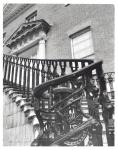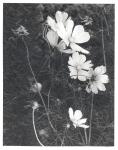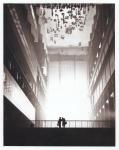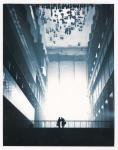I’ve just finished a short (10 week) course Improve you Photography with Chris Ould, at Central St. Martins. It split into two halves, the first concentraing on the theoretical side of things, basic modes of camera operation, composition, lighting, use of flash, etc, etc – all the usual expected subjects. At the end of each week, we’d have an assignment to do, one set on “form”, another on the subject of “motion”, another still on “lighting”. Finally was one examining people & their surroundings, for which I paid a visit to Columbia Road Flower Market. This assignment led into the second half of the course, working in the darkroom
First off was developing of film from our previous assignment – scans from the results as in the gallary. After that the real focus was on printing, where I was amazed to see just how much of a difference you can make to a photo. Selective cropping, enhanced contrast and very light toning made a significant improvement to this shot of tree branches.

Dodging, which is the technique of obscuring part of the scene/paper during exposure under the enlarger, makes it possible to bring out detail in dark parts of the scene while still giving the rest its normal exposure time. In this picture, the railings in the original were practically pure black, but dodging allowed the full detail to be pulled out.

In toning, previously developed prints are soaked in water and then put throug a bath containing one of many possible colourings. For the course, we had access to a copper tone and brown, almost sepia like tone. Having tried the tones on a handful of different prints you can see which tones suit a particular type of scene best. For example, the flowers below are most effective in brown.



While this shot of the Weather Project, at the Tate Modern, works best in the blue tone, taking on an almost apocalyptic feel.


All in all, the course was a huge success, and I’d definitely recommend anyone with more than a passing interest in photography to give it a try.
Thought the cold war was over? Well how would you like to know that the US has 100 nuclear weapons stationed in Suffolk – that’s three times more than they previously admitted to having here in the UK! Oh and that’s out of a total of almost 500 they hold across Europe. The Guardian dishes the dirt
“The fact that the United States has some 480 nuclear weapons still stationed in Europe will come as a surprise to a lot of Europeans,”
“The big question is: ‘Why are they still there more than a decade after the cold war ended?’ Neither the United States nor Nato has been able to articulate a credible mission for the weapons.”
Not only that, but in the event of war, the US would give the bombs to other Nato members’ airforces to drop on their behalf. Never mind the fact that some of these countries, Belguim, for example, are not nuclear powers. Oh well, if it ever got to that point, nuclear non-proliferation treaties would be the least of our worries.
But getting back to the point, with the cold war over, its surely about time to get rid of these weapons – they’re surely not too practical in the current ‘war on terrorism’ which rather transcends nation states and focuses on small groups / individuals. And please don’t mention the Dr Stangelove scenario!
On a lighter (sic) note, it no doubt came as some surprise to the Sudanese government to discover their country used to be a US nuclear test ground. Finally, those crazy particle physicists have created what looks remarkably like a small black hole in their lab. Guess the feasiblity rating for item number 7 in How to destroy the World just increased in magnitude a little and/or came forward a few hundred years.
So I’ve just spent a worthy couple of hours watching the film Sideways. Billed as a film about two men on a trip to experience the (Californian) world of wine, this is really just providing the backbone on which the real story. On the one hand is a guy in search of new direction in life 2 years after his divorce, while on the other is a guy in search of confirmation that his forthcoming marriage is right move for him to take. The resulting film forms an absorbing story with a surprising amount of subtle & not so subtle humour thrown in. And although its perhaps a little sad for what it says about relationships, for example, both leading characters ultimately getting away with their lies / transgressions, it does end on an optimistic with the film ending with both characters finding some sort of direction in which to continue their lives.
While browsing around Alex’s site I came across this diagram which somehow seems rather to be a fitting analysis of current my day-to-day working practices 







